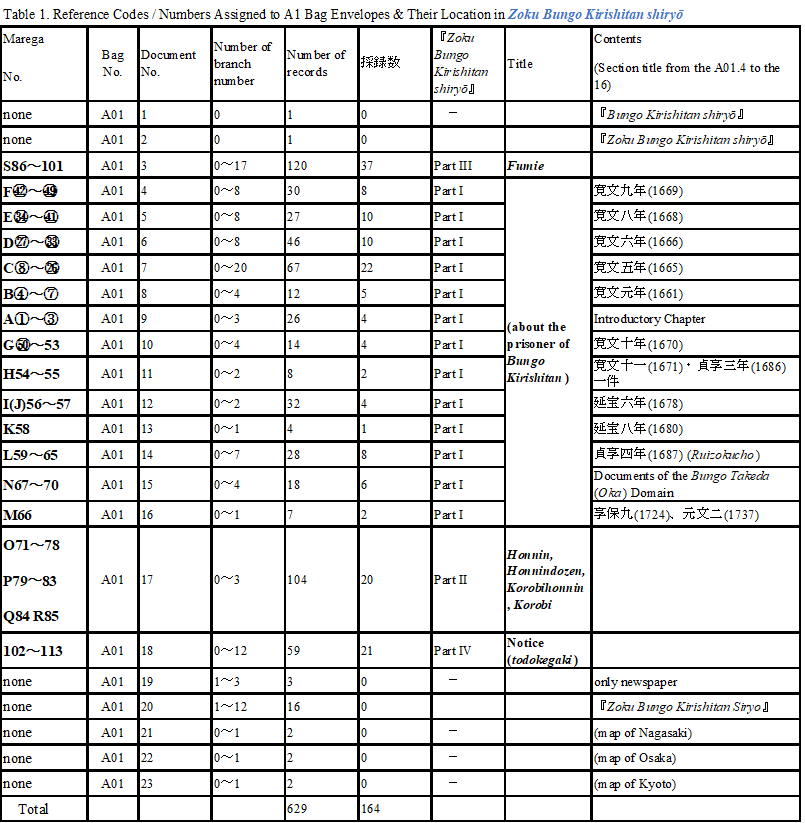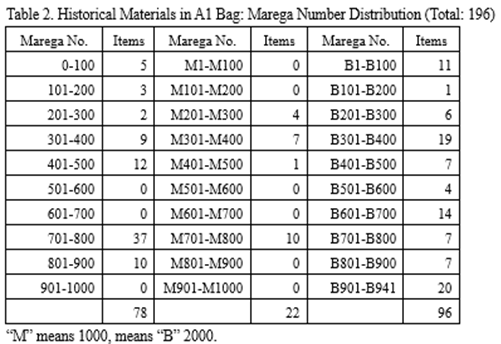- Reference Code
maregaA1
- Title
Vatican Library’s Fonds Marega (Bungo Christian Historical Documents) A1
- Date Range
1645 (Shōhō 3) – 1870 (Meiji 3)
- Primary Date Range
1645 (Shōhō 3) - 1870 (Meiji 3)
- Date Range Notes
Includes copy from 1938 (Shōwa 13), correspondence memos from the 1940s, and a 1949 (Shōwa 24) paystub.
- Description Level
File
- Quantity
629 catalogue entries. (148 jō状, 44 hōshi包紙, 35tatechō竪帳, 15 yokochō横帳, 13tsuzuri綴, 2 published books, 3 maps, 98 paper slips, 32 manuscripts, 3 postcards, 13 newspapers, 180 envelopes, 26 pieces of paper for wrapping etc.)
- Notes on Physical State
- Almost of the documents are organized using envelopes, wrappers, etc.
- Provenance / Creation
Mario Marega. Usuki Domain, Takeda Domain, etc.
- Scope and Content
File A1 consists of documents that Marega took out of his collection (documents included and assigned numbers in Marega’s hand-written catalogue [A16.4.4]) to store separately for inclusion in Zoku Bungo Kirishitan shiryō 続豊後切支丹史料 (Historical Documents Regarding Bungo Christians, vol. 2; below, Zoku). On the envelopes are written numbers Marega assigned to the documents (below, Marega Numbers), as well as reference codes and numbers that indicate their order within Zoku. When organizing these documents, we assigned subfile numbers (A1.1 to A1.23) to each group of items in envelopes and the like. The numbers of documents and groups of documents and where they appear in Zoku are shown in Table 1.
A1.1 is Bungo Kirishitan shiryō 豊後切支丹史料 (vol. 1). It includes many handwritten notes, such as the numbers of the documents appearing therein. It appears to have been sent by Marega to Rome in 1954. It was moved from the Vatican Library's collection into A1. A1.2 is Zoku. It includes handwritten corrections and memos. It was originally in this bag (A1).
A1.3 to A1.18 are documents that appear to have been grouped by the chapter in which they appear in Zoku. (Zoku is structured as follows: Part 1 – Chronologically ordered historical materials related to the uncovering of Christians during the Kanbun period [1661–1673]; Part 2 – Subsequent historical materials related to Christians, former Christians, and their families; Part 3 – Fumie: Part 4 – Various notifications; Part 5 – Materials other than the historical materials Marega collected). On the front side of the envelopes and wrappers are Marega Numbers as well as many Italian memos regarding content, titles, etc. and the readings of such Japanese text written in the Roman alphabet. Also included with many documents are memos on slips of paper and transcription. We can thereby see the process by which Marega deciphered and carried out research on these historical materials in order to compile Zoku. It appears that they were organized after Zoku was compiled. The pages upon which documents appear in the book are recorded on the envelopes and wrappers.
A1.20 is a manuscript of Zoku with many corrections. It includes layout notes and thus appears to have been the one he submitted to be published.
Marega Numbers are written on the documents. However, since these are groups of documents organized by chapter, in almost all cases the Marega Numbers are not consecutive. The distribution of these numbers is shown in Table 2.
A1 includes documents indicating where Marega acquired his document collection, such as a list of historical materials purchased from Motoyama Motozō 元山元造 (A1.9.2.1.1.4), a copy (A1.9.2.1.3.1) and letter (A1.9.3.2.2; envelope: A1.9.2.1.1.0) that appear to have been received from the same individual, and a document with a Hareruya Shoten ハレルヤ書店 (Hallelujah Bookstore) price tag (A1.3.14.1 Oka Domain). There are also documents (or copies of documents) that appear to have been received from Mieno 三重野 (Sachio 幸夫) (A1.4.1.0.1, etc.), a newspaper reporter from Takeda’s Oita Shimbun (A1.15.4.0), and other individuals.
Furthermore, based on the included memos written on slips of paper, it appears that other people such as Takahashi Shinkichi 高橋眞吉, Takayama Hideaki 高山英明, and Imamura Kōji 今村孝次 also were involved in the provision of historical materials and information, transcription revisions, manuscript reviewing, and so on.
A1.21–23 are woodblock print maps of Osaka, Nagasaki, and Kyoto. They might have been mixed in after A1 was put together. A1.1.9 consists solely of newspaper pages used as wrappers.
- Languages Used
Japanese, Italian, English
- Date Description Written
2016/11/27
- Reference Images


